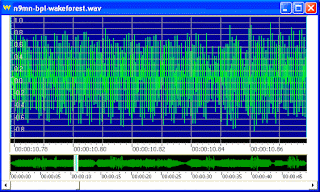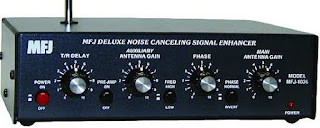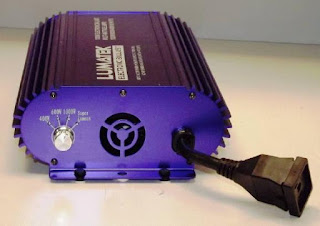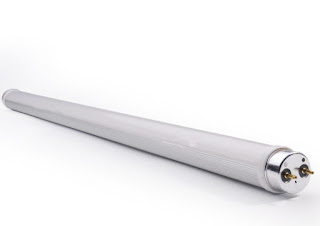Posts Tagged ‘QRN’
 RFI … Radio Spectrum’s Global Warming?
RFI … Radio Spectrum’s Global Warming?
 |
| courtesy: http://www.arrl.org/utilities |
The FCC's recent publication of an Order and Consent Decree (DA-17-471) has me wondering if this action signals new interest in cracking-down on those who manufacture and distribute unapproved spectrum polluting noise-generating devices or is it just a once-in-awhile muscle flex with little change in overall policy ... hopefully it's the former!
Highlights of the agreed upon notice:
Section 302 of the Act authorizes the Commission to promulgate reasonable regulations to minimize harmful interference by equipment that emits radio frequency energy....Specifically....that “[n]o person shall manufacture, import, sell, offer for sale, or ship devices or home electronic equipment and systems, or use devices, which fail to comply with regulations....
.... the Commission establishes technical requirements for transmitters and other equipment to minimize their potential for causing interference to authorized radio services ... the Commission administers an equipment authorization program to ensure that equipment reaching the market in the
United States complies with the technical and administrative requirements set forth in the Commission’s rules. The equipment authorization program requires, among other things, that radio frequency devices must be tested for compliance with the applicable technical requirements in accordance with one of three authorization procedures—i.e., certification, Declaration of Conformity, or verification—prior to marketing.
... the Rules prohibits the marketing of radio frequency devices unless the device has first been properly authorized, identified, and labeled in accordance with the Rules ...
... a privately-held company that manufactures and distributes lighting fixtures that are used in residential and commercial properties ... under-cabinet LED light fixtures were reportedly causing interference to AM/FM radio transmissions.
During the course of the investigation, the evidence revealed that ... the LED light fixtures were not tested and authorized under the Commission’s equipment authorization rules prior to marketing.
... the Bureau’s Spectrum Enforcement Division issued a Letter of Inquiry (LOI) ... directing to submit a sworn written response to a series of questions relating to ... the marketing of its LED lighting fixtures in the United States.
... continued to market the light fixtures at issue for certain times during an approximately five-month period after receipt of the LOI.
Other highlights indicate that the company in question acknowledged their violation and agreed to appoint a Compliance Officer in charge of implementing new company protocols, including the retraining and education of employees dealing with compliance issues. As well, a $90,000 civil penalty was imposed on the company for the violation.
As a point of interest, I can't ever recall seeing similar notifications being released or reported here in Canada by our FCC equivalent, the ISEDC. Hopefully they also take similar actions, but if so, they don't seem to be reporting it ... perhaps I'm just not looking in the proper places.
As I've mentioned here previously, for too many radio amateurs, the growing noise floor throughout the radio spectrum has become a global threat for the healthy pursuit of our hobby. Even if we saw the immediate implementation of rigorous new tight standards, crackdowns and prosecutions of offenders, it may already be too late to reverse the damage we are now seeing ... in many respects, it's the 'global warming' of the RF spectrum and there may be no turning back without immediate action.
 RFI … Radio Spectrum’s Global Warming?
RFI … Radio Spectrum’s Global Warming?
 |
| courtesy: http://www.arrl.org/utilities |
The FCC's recent publication of an Order and Consent Decree (DA-17-471) has me wondering if this action signals new interest in cracking-down on those who manufacture and distribute unapproved spectrum polluting noise-generating devices or is it just a once-in-awhile muscle flex with little change in overall policy ... hopefully it's the former!
Highlights of the agreed upon notice:
Section 302 of the Act authorizes the Commission to promulgate reasonable regulations to minimize harmful interference by equipment that emits radio frequency energy....Specifically....that “[n]o person shall manufacture, import, sell, offer for sale, or ship devices or home electronic equipment and systems, or use devices, which fail to comply with regulations....
.... the Commission establishes technical requirements for transmitters and other equipment to minimize their potential for causing interference to authorized radio services ... the Commission administers an equipment authorization program to ensure that equipment reaching the market in the
United States complies with the technical and administrative requirements set forth in the Commission’s rules. The equipment authorization program requires, among other things, that radio frequency devices must be tested for compliance with the applicable technical requirements in accordance with one of three authorization procedures—i.e., certification, Declaration of Conformity, or verification—prior to marketing.
... the Rules prohibits the marketing of radio frequency devices unless the device has first been properly authorized, identified, and labeled in accordance with the Rules ...
... a privately-held company that manufactures and distributes lighting fixtures that are used in residential and commercial properties ... under-cabinet LED light fixtures were reportedly causing interference to AM/FM radio transmissions.
During the course of the investigation, the evidence revealed that ... the LED light fixtures were not tested and authorized under the Commission’s equipment authorization rules prior to marketing.
... the Bureau’s Spectrum Enforcement Division issued a Letter of Inquiry (LOI) ... directing to submit a sworn written response to a series of questions relating to ... the marketing of its LED lighting fixtures in the United States.
... continued to market the light fixtures at issue for certain times during an approximately five-month period after receipt of the LOI.
Other highlights indicate that the company in question acknowledged their violation and agreed to appoint a Compliance Officer in charge of implementing new company protocols, including the retraining and education of employees dealing with compliance issues. As well, a $90,000 civil penalty was imposed on the company for the violation.
As a point of interest, I can't ever recall seeing similar notifications being released or reported here in Canada by our FCC equivalent, the ISEDC. Hopefully they also take similar actions, but if so, they don't seem to be reporting it ... perhaps I'm just not looking in the proper places.
As I've mentioned here previously, for too many radio amateurs, the growing noise floor throughout the radio spectrum has become a global threat for the healthy pursuit of our hobby. Even if we saw the immediate implementation of rigorous new tight standards, crackdowns and prosecutions of offenders, it may already be too late to reverse the damage we are now seeing ... in many respects, it's the 'global warming' of the RF spectrum and there may be no turning back without immediate action.
 MFJ-1026 Noise Canceller Tests At VA7MM
MFJ-1026 Noise Canceller Tests At VA7MM
 |
| courtesy: www.mfjenterprises.com/ |
Mark, VA7MM, has been testing out his newly-acquired MFJ-1026 Noise Canceller and has provided several videos of the noise canceller in action.
Like so many other hams, Mark's suburban location has seen a gradually rising noise floor and the noise heard in this video is from an off-site location within his local neighbourhood, located about 400m away.
The noise canceller requires a separate 'noise antenna' in order to cancel any noise on the main receiving antenna and for all of the tests shown below, Mark's noise antenna was a Cushcraft R-7 vertical while using an Icom IC-7600 transceiver for listening.
Test 1 shows the noise canceller being used while listening to a broadcast station on 6.0 MHz:
Test 2 shows the canceller's effect on raw noise while viewing in Spectran:
Test 3 shows the canceller's effect on a 40m CW signal:
Test 4 shows the effect of just the IC-7600's noise blanker on the offending noise:
Mark's comments:
Living in the noise cloud one must resort to special measures to use affected portions of spectrum. I recently purchased an MFJ-1026 noise canceller and have been testing the unit and have attached videos demonstrating the unit’s performance. You will see examples of raw noise, SW broadcast and 40 m CW signals with the unit being switched in and out. Also for comparison is the noise blanker in the IC-7600 failing to eliminate the same noise.
Conclusions:
- the unit is able to eliminate noise in most instances when adjusted properly
- the noise sense antenna is critical and several different switchable noise sense antennas may be required for good performance
- setting up on AM mode with Spectran helps with fine adjustment
- it outperforms the radio’s noise blanker in all cases tested
With proper tuning and set up, it looks like the MFJ-1026 can make a worthwhile improvement in unwanted noise reduction. Mark will also be testing and comparing a Timewave ANC-4 Noise Canceller with the MFJ and any videos received will be published here.
 MFJ-1026 Noise Canceller Tests At VA7MM
MFJ-1026 Noise Canceller Tests At VA7MM
 |
| courtesy: www.mfjenterprises.com/ |
Mark, VA7MM, has been testing out his newly-acquired MFJ-1026 Noise Canceller and has provided several videos of the noise canceller in action.
Like so many other hams, Mark's suburban location has seen a gradually rising noise floor and the noise heard in this video is from an off-site location within his local neighbourhood, located about 400m away.
The noise canceller requires a separate 'noise antenna' in order to cancel any noise on the main receiving antenna and for all of the tests shown below, Mark's noise antenna was a Cushcraft R-7 vertical while using an Icom IC-7600 transceiver for listening.
Test 1 shows the noise canceller being used while listening to a broadcast station on 6.0 MHz:
Test 2 shows the canceller's effect on raw noise while viewing in Spectran:
Test 3 shows the canceller's effect on a 40m CW signal:
Test 4 shows the effect of just the IC-7600's noise blanker on the offending noise:
Mark's comments:
Living in the noise cloud one must resort to special measures to use affected portions of spectrum. I recently purchased an MFJ-1026 noise canceller and have been testing the unit and have attached videos demonstrating the unit’s performance. You will see examples of raw noise, SW broadcast and 40 m CW signals with the unit being switched in and out. Also for comparison is the noise blanker in the IC-7600 failing to eliminate the same noise.
Conclusions:
- the unit is able to eliminate noise in most instances when adjusted properly
- the noise sense antenna is critical and several different switchable noise sense antennas may be required for good performance
- setting up on AM mode with Spectran helps with fine adjustment
- it outperforms the radio’s noise blanker in all cases tested
With proper tuning and set up, it looks like the MFJ-1026 can make a worthwhile improvement in unwanted noise reduction. Mark will also be testing and comparing a Timewave ANC-4 Noise Canceller with the MFJ and any videos received will be published here.
 Got Noise?
Got Noise?
 |
| courtesy: ARRL's Utility Noise (RFI) Signatures |
Excuse me if I seem somewhat cynical, but where have they been for the past twenty years as RF pollution, of now unbelievable proportions, has become the norm for most amateurs living in populated regions? In view of the present ubiquitous level of noise pollution, asking this question now is really akin to closing the barn door long after the horses have escaped ... and sadly, they are going to be very difficult, if not impossible, to round-up.
As radio amateurs, we are probably high on the list of those most negatively impacted by unwanted RF crud and were probably the first to bring this issue to the forefront. Many amateurs have watched, and continue to watch helplessly, as their noise floors climb higher and higher. For some, it happened overnight. In major cities and suburbs, it has become increasingly difficult to listen to normal AM radio because of RF noise pollution, so it's not just hams who are affected.
In many cases, the noise is powerline related and although this is part of the inquiry, in most cases this is probably not the main problem. Powerline noise is well acknowledged and here in Canada, RF pollution stemming from powerline radiation is illegal. Hydro authorities are required to clean-up noisy lines by government mandate (Industry Canada) and seem to react positively to complaints by amateurs. I believe a similar mandate is in play south of the border but because of the vast numbers of hydro operators operating in so many jurisdictions, getting action often seems fraught with difficulty.
The inquiry seems focused on the more nefarious types of radiation sources ... those that are not powerline-related, such as RFI caused by switching power supplies, light dimmers, electric motors, high efficiency lighting, computers, portable electronic devices, wireless routers ... generally any type of device radiating unwanted RF emissions.
Presently, complaints about this type of RF noise to governing bodies or to national associations, mostly seem to go without effective response ... solutions to the problem seem to be left to the amateur to "fix" the offending device or to just "accept it", rather than to put responsibilities on the manufacturers creating the problems. I know personally of amateurs who have just given up the hobby or have moved to the countryside because of impossibly-high illegal noise levels. It seemed as if calls for tighter government controls on electronic device emission-levels, especially on inexpensive and poorly-designed imports, largely from the far east, fell upon deaf ears. Some European jurisdictions found a ridiculous solution to the growing complaints by slackening even further, the allowable 'accepted' levels of spurious emissions. Previously illegal noise-making devices became legal overnight!
In the meantime, noisy electronic devices continue to flood the market at exponential levels ... only now, does the FCC pose this mind-boggling question! Equally stunning is their assertion that "... in search for concrete evidence of increased noise floors, we have found limited quantitative data to support this presumption." Perhaps if they had been maintaining vigilance instead of ignoring complaints when the problems were first reported, they would already have a huge body of the 'quantitative data' they are now seeking.
The Technical Advisory Council Noise Floor Inquiry (ET Docket No. 16-191) is well worth reading for any radio amateurs interested in finding solutions to growing noise problems. The three-page document includes a short list of questions to which responses are sought ... your input is vital, especially if hard data can accompany your comments.
Is it too late to turn the tide? There is no doubt that at this late date, it will be a huge uphill climb. The public notification document can be found here and the deadline for submissions, which can be made here, is August 11, 2016.
 More ‘Hydroponic’ RF
More ‘Hydroponic’ RF
 |
| courtesy: arrl.org |
Some of the test products were ordered and purchased through Amazon and through Sears ... the ARRL's thorough report makes it obvious that rules are being ignored and amateurs are paying the price.
“The level of conducted emissions from [these devices] is so high that, as a practical matter, one RF ballast operated in a residential environment would create preclusive interference to Amateur radio HF communications throughout entire neighborhoods,” ARRL General Counsel Chris Imlay, W3KD, wrote in each complaint. The devices exceeded conducted emission limits under all test conditions, “sometimes by extreme margins, throughout most of the HF range ...”
In a similar vein as its recent complaint about marketing of certain RF lighting devices by The Home Depot, the ARRL pointed out that there were no FCC labels on two of the devices mentioned nor any FCC compliance information “anywhere in the documentation, or in or on the box, or on the device itself,” in violation of FCC Part 18 rules.
The League asked the FCC to require removal of all such illegal “grow light” devices from retail sale and marketing and the recall of those devices already sold or available for retail sale, and it said the device importers should be subject to a forfeiture proceeding.
With the proliferation of both legal and illegal 'hydroponic' operations, this kind of QRN is probably just the tip of the iceberg. It's good to see the ARRL slowly pounding away at the rule-breakers on behalf of American amateurs.
I see these same devices being sold on E-Bay, where presumably, they could be purchased worldwide and installed anywhere. As well, several of the U.S. online dealers state "We ship to Canada" ... just great.
Hopefully Industry Canada and RAC are gearing-up for the fight.
 Fluorescent Light QRN
Fluorescent Light QRN

A recent posting on the ON4KST 6m Chat page brought up the question of QRN coming from fluorescent lighting.
Lefty, K1TOL, had a lot of QRN coming from his neighbour's garage, about 1,000 feet away. He solved the problem by changing the ballasts, purchased at Home Depot. This is the ballast that solved his problem, so if you are having similar difficulty, perhaps this will be of benefit.
Sometimes just changing to a different bulb type (manufacturer) will solve the problem as well but from what I have read, you get what you pay for and likely the bargain-bin bulbs are not the quietest.











